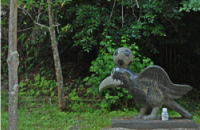Episode 6:
Led by a Divine Revelation
From the Kojiki, Volume II
“Eastern Expedition of Emperor Jimmu”
Kamu-yamato-iware-biko no Mikoto (later known as Emperor Jimmu, a descendent of the Japanese sun goddess Amaterasu-omikami) was living in his Takachiho palace in Himuka, which is now present day Miyazaki Prefecture, with his elder brother Itsuse no Mikoto. However, the brothers decided to move east in order to find a better location for reigning over the entire country.
The brothers left Himuka, and passed through Toyo-no-kuni (now Oita), Tsukushi (now Fukuoka), Aki-no-kuni (now Hiroshima) and Kibi (now Okayama), finally reaching Shirakata-no-tsu (Shirakata Bay in Osaka), where they were defeated in a battle against Tomi-no-nagasune-biko. Itsuse no Mikoto was wounded in the fight and died soon afterwards. Kamu-yamato-iware-biko no Mikoto sailed around the Kii Peninsula and landed in Kumano, where he defeated a savage deity with the help of his divine sword. After the battle, he headed for Yamato (now Nara Prefecture).
Then, Kamu-yamato-iware-biko no Mikoto received a prophecy from Takagi-no-kami: “Son of the Heavenly Deity, do not go deep into the mountains now. There are numerous savage deities there. I will send you the yāta-garasu, a crow with three legs, to serve as your guide. Wait here for the crow and follow it to Yamato.”
The yāta-garasu appeared in front of Kamu-yamato-iware-biko no Mikoto and led him and his party to the lower course of the Yoshino River. There, Kamu-yamato-iware-biko no Mikoto asked a fisherman his name. The man answered, “I’m an earthly deity, and a son of Niemotsu.”Kamu-yamato-iware-biko no Mikoto continued on his journey when a man with a tail came out of a shining well and said, “I’m an earthly deity. My name is Ihika.” When Kamu-yamato-iware-biko no Mikoto went deeper into the mountains, another man with a tail appeared, pushing open huge rocks. He said, “I’m an earthly deity, and a son of Iwa-oshiwaku. I came here because I was told that the son of the Heavenly Deity was coming.”
Thereafter, Kamu-yamato-iware-biko no Mikoto was victorious in every battle he fought. He defeated Eukashi in Uda, Tsuchigumo no Yaso-takeru in Ossaka (now Sakurai City, Nara Prefecture), Nagasune-biko to avenge his elder brother Itsuse no Mikoto, and conquered Eshiki and Otoshiki, brothers from one of the most influential families in the area.
Then, Nigi-hayahi no Mikoto, descended from the heavens to speak with Kamu-yamato-iware-biko no Mikoto, telling him “I heard that the son of the Heavenly Deity was coming, so I came to see him.” He then presented Kamu-yamato-iware-biko no Mikoto with a family heirloom proving that he too was a son of the Heavenly Deity.
After Kamu-yamato-iware-biko no Mikoto finished subduing the savage deities and repelling numerous enemies, he built Kashihara-no-miya―the imperial palace of Kashihara―in Unebi, and started to govern his empire as Emperor Jimmu. His expedition to the east finally came to an end after more than 16 years of travelling.
Related site:
Yatagarasu-jinja Shrine, Haibara, Uda City
In the tale of Kamu-yamato-iware-biko no Mikoto’s expedition to the east, the enshrined deity Taketsunumi no Mikoto was described as being personified by the yāta-garasu who guided and led the future emperor’s army from Kumano to Yamato. Traditions say that Yatagarasu-jinja Shrine was first established in 705, the second year of Keiun, and that clans such as the Otomo clan and the Kamo clan, the supposed descendants of the yāta-garasu, worked hard together to hold religious services there. In recent years, Yātagarasu-jinja Shrine has become known as a shrine for safety and victory in sports. In the shrine’s precincts, there is a statue of the yāta-garasu heading a soccer ball.
